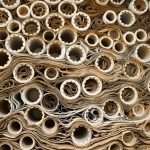You've probably wondered what really happens to your old clothes after you drop them off at a recycling bin. While many assume they're simply tossed aside, the truth is far more complex and fascinating. From the moment they're collected, these textiles embark on a detailed journey of sorting, processing, and transformation. But what innovative products emerge from this cycle, and how do they impact our environment? As you explore this topic, you'll uncover surprising truths about the potential of recycled fabrics and their role in shaping a sustainable future.
Table of Contents
Key Takeaways
- Recycled fabrics are collected from various sources, including old clothes and local manufacturers, to initiate a sustainable journey.
- After collection, fabrics undergo sorting and grading to determine their type, condition, and suitability for reuse or recycling.
- Processing techniques involve either mechanical methods, which are energy-efficient, or chemical processes that yield higher-quality fibers, depending on sustainability goals.
- Recycled textiles are transformed into diverse products, such as fashion accessories, home décor, and automotive interiors, promoting creativity and sustainability.
Collection of Recycled Fabrics
When you gather recycled fabrics, you're not just collecting materials; you're starting a sustainable journey. Each piece you collect contributes to reducing waste and conserving resources. You might find fabrics from old clothes, upholstery, or even leftover scraps from local manufacturers. By sourcing these materials, you're actively participating in a movement that values circular economy principles.
As you collect, consider the different types of fabrics. Cotton, polyester, and wool each have unique properties that can be repurposed in various ways.
You can reach out to friends, family, or local organizations to gather unwanted textiles. Many communities have designated drop-off centers or collection events where you can contribute.
Sorting and Grading Process
When you collect recycled fabrics, the next step is crucial: sorting and grading.
You'll learn about various collection methods and the techniques used to categorize materials effectively.
Understanding the grading criteria is essential for ensuring that the right fabrics are processed for recycling.
Collection Methods Explained
The collection methods for recycled fabrics involve a meticulous sorting and grading process that ensures only the best materials are repurposed.
After fabrics are collected, the first step is to separate them based on type, color, and condition. You'll notice that this initial sorting plays a crucial role in determining the fabric's future use.
Once the materials are sorted, they undergo grading, where each piece is evaluated for quality. This assessment helps identify which fabrics can be reused as-is and which ones need further processing. You might find that some fabrics, like cotton or wool, are often graded higher due to their versatility and durability.
After grading, the fabrics are packaged and sent to the appropriate recycling facilities. Here, they'll be cleaned, processed, and transformed into new products.
It's important for you to understand that this sorting and grading process not only maximizes resource efficiency but also minimizes waste. By ensuring that only high-quality materials make it through, you're contributing to a more sustainable textile industry.
This journey of collected fabrics sets the stage for a brighter, greener future.
Sorting Techniques Overview
Various sorting techniques play a vital role in ensuring fabrics are accurately categorized for recycling. When you think about the journey of recycled textiles, the initial sorting process is crucial. You might be surprised to learn that this involves both manual and automated methods.
In manual sorting, trained workers evaluate each fabric item, checking for fiber content, color, and condition. They use their expertise to make quick decisions about which items are suitable for recycling and which ones should be discarded. This hands-on approach ensures that only the best materials are prepared for the next steps in the recycling process.
On the other hand, automated sorting technologies have become increasingly popular. These systems utilize advanced sensors and artificial intelligence to identify fabric types and sort them accordingly. They can handle large volumes of textiles efficiently, saving time and labor costs while increasing accuracy.
Grading Criteria Importance
Understanding grading criteria is essential for effectively sorting fabrics, as it directly impacts the quality of recycled materials. When you're involved in the sorting process, you need to recognize how various factors, like fabric type, condition, and color, influence the final product's viability. By applying appropriate grading criteria, you ensure that only the best materials make it through for recycling.
You'll want to categorize fabrics into distinct grades based on their wear and tear. For instance, top-grade materials are often suitable for upcycling or resale, while lower grades might end up as insulation or industrial rags. This distinction helps maximize the value of each fabric type, promoting a more sustainable recycling process.
Additionally, clear grading criteria streamline operations. When everyone understands what qualifies as different grades, it minimizes confusion and mistakes during sorting. It also allows for better inventory management, as you can easily track which grades are in demand.
In short, employing rigorous grading criteria not only enhances the quality of recycled fabrics but also fosters a more efficient and sustainable recycling system. Your careful attention to these criteria can significantly influence the success of fabric recycling initiatives.
Processing Techniques for Fabrics
When it comes to processing recycled fabrics, sorting and separation are crucial first steps.
You'll see how mechanical and chemical processes play distinct roles in transforming these materials into new textiles.
Let's explore these techniques and their impacts on the recycling journey.
Sorting and Separation
Sorting and separation are crucial steps in processing recycled fabrics, ensuring that materials are properly categorized for effective recycling.
When you bring your old clothes to a recycling facility, the first thing that happens is a thorough inspection. Workers look for different fabric types, like cotton, polyester, and nylon. This initial assessment allows them to determine the best recycling method for each material.
Next, you'll see the fabrics being separated based on color and composition. This is important because certain fabrics can't be recycled together due to differing melting points or chemical properties. Automated machines often assist in this process, using technology to identify and sort materials more efficiently.
After sorting, the fabrics are grouped into bales, ready for the next stage of recycling. You might notice that this process not only organizes the materials but also minimizes contamination, which could hinder recycling efforts.
Mechanical Vs. Chemical Processes
Recycling fabrics involves two primary processing techniques: mechanical and chemical methods, each offering distinct advantages for transforming old textiles into new materials. Mechanical processes typically involve shredding, carding, and spinning fibers to create recycled yarns. This method is often more sustainable, as it requires less energy and generates less waste. However, it can compromise the quality of the fibers, limiting their use in high-end textiles.
On the other hand, chemical processes break down the materials at a molecular level, allowing for the creation of high-quality fibers suitable for various applications. While these methods can produce superior results, they often involve more energy and chemicals, raising environmental concerns.
Here's a quick comparison of both methods:
| Method | Advantages |
|---|---|
| Mechanical | Energy-efficient, lower waste generation |
| Chemical | High-quality output, versatile applications |
Ultimately, choosing between mechanical and chemical methods depends on the desired end product and sustainability goals. By understanding these techniques, you can make informed decisions about the recycling processes that best align with your values.
Manufacturing New Products
Manufacturing new products from recycled fabrics not only reduces waste but also sparks innovation in sustainable design.
You're not just giving materials a second life; you're also driving creativity and efficiency in the fashion and textile industries. By transforming discarded textiles into high-quality products, you're helping to create a circular economy where resources are continually reused, minimizing the need for virgin materials.
When you engage in this process, you'll find that recycled fabrics can be repurposed into various items, from clothing and accessories to home goods and industrial textiles. Each time you choose a product made from recycled materials, you're supporting businesses that prioritize sustainability and ethical practices.
The manufacturing techniques employed can vary, but they often involve careful selection and processing of fabrics to maintain quality. You might be surprised at how effectively these recycled materials can mimic the properties of new fabrics, offering durability and style without the environmental impact.
Ultimately, by participating in the market for products made from recycled fabrics, you're not only making a conscious choice but also influencing the broader movement towards sustainable manufacturing practices.
Innovative Uses of Recycled Textiles
Recycled textiles are being creatively transformed into everything from stylish handbags to durable insulation for buildings, showcasing their versatility and potential. You might be surprised at how many innovative applications these materials have found in various industries. By repurposing old fabrics, designers and manufacturers aren't only reducing waste but also creating unique products that stand out.
Here are some exciting uses of recycled textiles you should know about:
- Fashion accessories: Upcycled materials are being used to create eye-catching handbags, belts, and shoes that make a statement.
- Home décor: Recycled fabrics are woven into rugs, curtains, and cushions, adding a touch of sustainability to your living space.
- Automotive interiors: Some car manufacturers are incorporating recycled textiles into seat covers and upholstery, promoting eco-friendly driving experiences.
Environmental Impact and Benefits
With the rise of innovative uses for old fabrics, understanding their environmental impact and benefits becomes increasingly important. Recycling textiles helps reduce waste in landfills, where discarded clothing can take years to decompose.
By choosing recycled fabrics, you're not only giving new life to materials but also significantly cutting down on the demand for virgin resources, which often require intensive energy and water usage to produce. Recycling fabrics also lowers greenhouse gas emissions, as manufacturing new textiles contributes heavily to air pollution.
When you support recycled textiles, you're backing a more sustainable approach that conserves energy and mitigates climate change. Additionally, the process of recycling fabrics generally consumes less water compared to traditional textile production, preserving this vital resource.
Moreover, using recycled materials fosters a circular economy, where products are reused and repurposed rather than discarded. This shift promotes responsible consumption and encourages manufacturers to design with sustainability in mind.
Future of Recycled Fabrics
The future of fabrics looks promising as innovations in recycling technology continue to advance, making it easier for you to choose sustainable options. With brands and manufacturers increasingly focusing on eco-friendly practices, you'll find more products made from recycled materials. Here's what you can expect in the future:
Improved Recycling Processes: New methods will enable you to recycle a wider variety of fabrics, including blended materials that were previously difficult to process.
Increased Availability: As demand grows, you'll see a broader range of clothing and textiles made from recycled fabrics in stores, making sustainable choices more accessible.
Enhanced Quality: Advances in technology will lead to higher-quality recycled fabrics that rival traditional materials in durability and feel.
Circular Fashion Initiatives: More brands will adopt circular fashion principles, encouraging you to return your old clothes for recycling and reducing waste.
Frequently Asked Questions
How Can I Properly Recycle My Old Clothes at Home?
To properly recycle your old clothes at home, sort them by fabric type, check for local recycling guidelines, and consider repurposing. You can also donate usable items to charities or friends in need.
Are All Types of Fabrics Recyclable?
Not all fabrics are recyclable. Natural fibers like cotton and wool usually are, while synthetic materials like polyester and nylon can be trickier. Check with your local recycling program to see what they accept.
What Happens to Fabrics That Cannot Be Recycled?
When fabrics can't be recycled, they often end up in landfills, contributing to waste. Some may be repurposed for insulation or cleaning rags, but many simply linger, impacting the environment negatively. It's crucial to reduce waste.
Can Recycled Fabrics Be Harmful to My Health?
Recycled fabrics can sometimes contain harmful chemicals or allergens, especially if not properly processed. However, most reputable brands ensure their products meet safety standards, so it's essential to choose trusted sources for your fabrics.
How Do I Find Companies That Use Recycled Fabrics?
To find companies using recycled fabrics, search online for sustainable brands, check eco-friendly fashion directories, and explore social media platforms. You can also visit local thrift stores that might carry items made from recycled materials.
- Your Guide to Scrim Fabric for Fences and Outdoor Shade Structures - June 26, 2025
- Acoustic Scrim Fabric: How to Improve Sound Quality in Any Space - June 26, 2025
- The Role of Carbon Laid Scrims in High-Performance Composites - June 26, 2025







